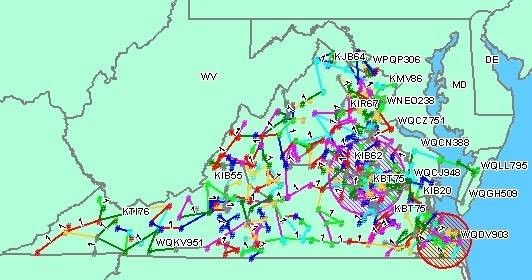By Jeff Cohen
Last year, I wrote a blog titled “New FCC Spectrum Rules Put Public Safety Communications at Risk.” As I explained, the FCC adopted new rules to allow Wi-Fi routers to freely operate throughout a major spectrum band that is heavily relied upon by public safety agencies for “microwave” communications. APCO and other parties protested and asked the FCC to repeal the new rules. Unfortunately, the FCC rejected our requests. Now, I’m writing with an update to describe APCO’s decision to sue the FCC in federal court to reverse the new rules and where things stand.
A Quick Refresher on 6 GHz Spectrum
The 6 GHz spectrum band is the backbone of emergency communications throughout the country. Think of it as a system of major highways connecting public safety networks and agencies to each other. For example, 6 GHz links are used to transmit 9-1-1 dispatch information to fire stations, and to connect public safety land mobile radio communications towers, linking first responders to each other. 6 GHz links span many miles and thus are key to supporting communications in remote areas where there are few, if any, alternatives.
To give you an idea of how pervasive public safety use of the band is, here’s a view of the public safety microwave links in my home state of Virginia:

All across the country, 6 GHz links hum every minute supporting communications for 9-1-1 centers and first responders. If there’s interference to 6 GHz systems, communications critical to the safety of life are put at risk. For decades, public safety has relied upon this band, which is subject to careful prior frequency coordination and intended for extreme reliability. In fact, these links are designed to prevent interruptions longer than 30 seconds per month, with some not tolerating more than 30 seconds of downtime per year. It is this reliability that makes the spectrum so important for public safety.
What the FCC Did
In April 2020, the FCC changed the spectrum rules. Whereas before, using 6 GHz spectrum generally required a formal license from the FCC (making it relatively straightforward to avoid and resolve interference), now the entire band is available for unlicensed use by devices like Wi-Fi routers. What motivated this drastic change? Some tech companies say they need more spectrum to support Wi-Fi and other consumer electronics. Since spectrum is a finite natural resource, attention has turned to ways to share spectrum presently in use with new applications. Proponents of Wi-Fi and 5G products and services turned their eyes to the 6 GHz band.
As a general matter, APCO is not totally against having public safety share spectrum with other users, in the interests of helping to promote overall spectrum efficiency. But APCO has been clear that any mechanism to be deployed to share public safety spectrum must be tested and proven to work in advance. That is an entirely reasonable position to hold, given the potential harm to public safety if something were to go wrong or not work as expected. Spectrum sharing technologies are nascent and up to this point haven’t been applied to public safety bands.
In addition to requiring spectrum sharing technologies to be proven to work before they’re used in the real world, APCO has held another entirely reasonable stance: even if proven effective in advance, no sharing mechanism will be reliable enough to completely prevent interference. And when it comes to public safety, you just can’t take unnecessary risks. So, in addition to a successfully-tested-in-advance spectrum sharing technology being used to prevent interference, there needs to be an additional mechanism to detect, identify, and eliminate interference that does occur.
Unfortunately, despite APCO’s repeated advocacy in support of these two entirely reasonable propositions, the FCC declined to require testing in advance, and did not adopt any additional protective measures. Making matters worse is that the new uses being introduced into the 6 GHz band are of the kind that will be nearly impossible to track or recall. There are going to be hundreds of millions, if not more, of these new “unlicensed” Wi-Fi and similar devices flooding the marketplace. They will be bought at consumer-oriented e-commerce and brick-and-mortar stores, and deployed throughout homes and businesses, freely transmitting over the same spectrum that public safety microwave systems use.
Suing the FCC
After APCO exhausted its remedies at the FCC, we made the decision to appeal the FCC’s order in the U.S. Court of Appeals for the D.C. Circuit. Filing a lawsuit was a drastic step. This isn’t the first time APCO has disagreed with an FCC decision, but this is a unique situation with a significant risk of irreversible harm to public safety. Indeed, multiple parties are suing the FCC over these rules.
Public safety users aren’t the only “incumbents” in this band that are threatened by the FCC’s decision. There are commercial operators like AT&T, electric utilities, and broadcasters that also use this band for their own specific purposes and filed suit. For the sake of efficiency, the Court ordered us all to join together and write a common brief to make our legal arguments.
While working with these other parties, it became clear that the potential impacts on public safety users are unique from the risks other parties face. APCO is the sole litigant that directly represents the 9-1-1 centers and police, fire, and EMS departments that depend on the 6 GHz band to literally save and protect lives. Even though the other parties have safety-related concerns, such as the potential problems of interference to electric utilities, APCO was responsible for making sure that the arguments being made to the court reflected the unique requirements of public safety.
What Happens Next?
Pursuant to a court-mandated timeline, the parties suing the FCC filed their primary legal brief in December. The FCC’s response is due in February.
Be on the lookout for interference. It’s important to note that, while APCO and others are suing the FCC to reverse the new 6 GHz rules, the FCC is already starting to allow the marketing and sale of new devices that will take advantage of the rules. Wi-Fi routers using the same spectrum as public safety agencies could soon be in any office, apartment, or house. Given the lack of FCC-backed protections, some experts have suggested that existing 6 GHz users take measurements of the spectrum environment now so it will be easier to demonstrate that interference is a result of the new unlicensed devices. This takes time, money, and in some cases resources that agencies don’t have. Hopefully, before too many of the new devices roll out we’ll get the court to force the FCC to adopt a better approach to prevent and eliminate interference before it’s too late.
Also, as part of a sweeping funding law, Congress recently expressed concern that the new 6 GHz rules could result in interference to incumbent users and harm critical communications infrastructure. In March, the FCC must deliver a report to Congress on its progress in “ensuring rigorous testing related to unlicensed use of the 6 gigahertz band.”
We will continue to vigorously pursue the court case, which will extend for many months into 2021, and we’ll seek the strongest possible interpretation of the FCC’s new obligation to ensure rigorous testing is performed to protect critical communications. We will also advocate in public safety’s best interests as the FCC explores additional rule changes that could further threaten public safety operations. In the meantime, we will also carefully monitor the introduction of new unlicensed devices for any signs of interference.
You can contact APCO’s Government Relations Office with any feedback by emailing [email protected].

About the TabletopX Blog
A “Tabletop Exercise,” often shortened as “TTX,” is a discussion-based exercise frequently used by emergency planners. Led by a facilitator using a planned scenario, TTX participants describe the actions they would take, and the processes and procedures they would follow. The facilitator notes the players’ contributions and ensures that exercise objectives are met. Following the exercise, the facilitator typically develops an after-action report and conducts a debrief discussion during which players and observers have an opportunity to share their thoughts, observations, and recommendations from the exercise without assigning fault or blame.
Many of the attributes of a TTX are the same we seek to promote in the discussion generated from our blog posts. The goal is to capitalize on the shared experiences and expertise of all the participants to identify best practices, as well as areas for improvement, and thus achieve as successful a response to an emergency as possible.
TabletopX blog posts are written by APCO’s Government Relations team and special guests.
Latest TabletopX Posts
-
APCO’s Advocacy Priorities for 2024
-
More Information than You Ever Wanted about Fixing the Federal Classification of 9-1-1 Professionals
-
APCO’s Regulatory Priorities for 2023
-
APCO’s 2023 Advocacy Priorities (with one-pagers of talking points)
-
Regulatory Update from APCO’s Chief Counsel at APCO 2022
-
Talking Points for APCO’s Legislative Priorities